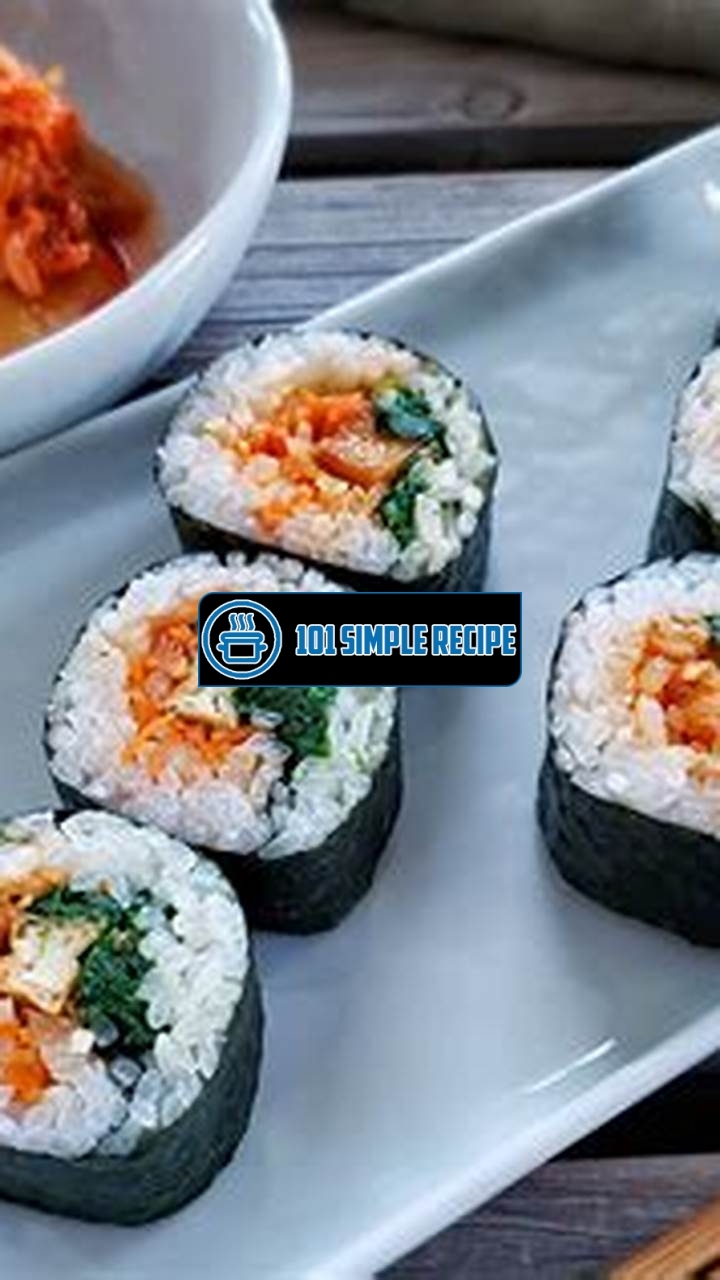Welcome to the world of delicious Korean seaweed rolls! In this article, you will learn how to master the art of creating these mouthwatering treats that are loved by many around the globe. Whether you are a fan of Korean cuisine or simply looking to try something new, this guide will take you through the process step-by-step, ensuring that you achieve perfect results every time. With the help of colorful images, we will provide visual aids to assist you in recreating this traditional Korean dish in your own kitchen. So grab your apron and get ready to embark on a culinary adventure that will surely delight your taste buds!

Exploring Korean Seaweed Roll
Discover the savory and nutritious delight of Korean seaweed roll, a popular Korean dish.
The Origins of Korean Seaweed Roll
Korean seaweed roll, also known as kimbap or gimbap, has a rich history that can be traced back to the early 1900s. It originated as a portable snack in the streets of Korea and gradually became a staple in Korean cuisine. The roll is made by wrapping seasoned rice, vegetables, and sometimes meat in seaweed sheets. Today, it is enjoyed by people of all ages and is commonly found in Korean restaurants and households.
Traditionally, the seaweed used in Korean seaweed roll was harvested from the shores of Korea. However, with advancements in technology and transportation, seaweed is now readily available in markets worldwide. The preparation process involves toasting the seaweed to enhance its flavor and crunchiness, which adds a delightful texture to the roll.
The Versatility of Korean Seaweed Roll
One of the reasons why Korean seaweed roll is so beloved is its versatility. It can be customized to suit various tastes and dietary preferences. Whether you are a vegetarian or a meat lover, there is a seaweed roll for everyone.
Vegetarian options include fillings like pickled radish, carrots, cucumber, and seasoned tofu. For those who enjoy meat, popular options include beef, chicken, or fish. The fillings can also be combined to create unique flavor combinations. The roll can be served as a light snack, a side dish, or even a main course, depending on the ingredients used and the size of the roll. ️
The Health Benefits of Korean Seaweed Roll
Apart from its delicious taste, Korean seaweed roll offers several health benefits. Seaweed is a nutrient-rich ingredient that is packed with vitamins, minerals, and antioxidants. It is an excellent source of iodine, which is essential for thyroid function. The roll also provides a good amount of fiber, protein, and healthy fats.
Additionally, the vegetables used in the roll contribute to its nutritional value. They provide essential vitamins and minerals, along with dietary fiber. The combination of these ingredients makes Korean seaweed roll a well-rounded and nourishing dish.
In conclusion, Korean seaweed roll is a versatile and nutritious dish that has gained popularity not only in Korea but also worldwide. Its origins, versatility, and health benefits make it a delightful option for those looking to explore and enjoy Korean cuisine. So why not give it a try and experience the delectable flavors of Korean seaweed roll for yourself? Bon appétit! ️
If you’re looking to lose weight, try this weight loss recipe from 101 Simple Recipe.
Choosing the Perfect Ingredients
When it comes to creating delicious Korean seaweed rolls, selecting the right ingredients is crucial. Each element contributes to the overall taste and texture of the dish, ensuring a satisfying culinary experience. Let’s delve into the key components that make up this delightful delicacy.
Seaweed Selection: Finding the Perfect Nori
The first step in creating Korean seaweed rolls is choosing the ideal nori, a type of edible seaweed that serves as the outer layer of the roll. Nori comes in different varieties, so it’s important to understand the characteristics of each type.
The most common nori used for seaweed rolls is known as “gim” in Korean. It has a dark green color and a slightly salty, briny taste. This variety is often roasted to enhance its flavor and crispness. If you prefer a lighter and more delicate taste, you can opt for “tegusa” nori, which has a lighter green color and a milder flavor.
Regardless of the type of nori you choose, make sure it is fresh and free from any signs of discoloration or rips. This will ensure that your seaweed rolls have a visually appealing appearance and a pleasant texture.
Filling Options: Traditional and Creative Choices
The filling is what adds depth and variety to your Korean seaweed rolls. While traditional fillings include vegetables, meat, and seafood, there’s plenty of room for creativity and experimentation. Here are some popular filling options:
- Traditional Fillings:
- Julienne-cut carrots, cucumbers, and radishes
- Thinly sliced beef, pork, or chicken
- Marinated tofu
- Steamed shrimp or crab meat
- Omelette strips
- Creative Fillings:
- Avocado slices
- Kimchi for a spicy kick
- Cream cheese for added creaminess
- Fried tofu for a crispy texture
- Mango slices for a sweet and tangy flavor
Feel free to combine traditional and creative fillings to create a unique and appetizing blend of flavors.
Additional Ingredients: Enhancing Flavor and Texture
To take your Korean seaweed rolls to the next level, consider incorporating additional ingredients that enhance the overall flavor and texture. Here are some examples:
- Sesame oil: Adds a rich and nutty taste
- Soy sauce: Provides savory umami notes
- Gochujang (Korean chili paste): Adds a spicy and slightly sweet kick
- Sesame seeds: Introduces a crunchy texture and nutty flavor
- Rice vinegar: Balances the flavors and adds a tangy note
These additional ingredients can be used as dipping sauces or drizzled over the filling for an extra burst of flavor. Don’t be afraid to experiment and find your perfect combination!
The Art of Rolling
When it comes to making delicious Korean seaweed rolls, mastering the art of rolling is essential. This technique involves a series of steps that ensure your rolls are tightly wrapped and visually appealing. By following these techniques, you can create perfect Korean seaweed rolls that are sure to impress your friends and family.
Preparing the Rice: Achieving the Right Texture
Use short-grain rice: The foundation of a good Korean seaweed roll is the rice. Make sure to use short-grain rice, as it has a stickier texture that holds the roll together.
Rinse the rice: Before cooking the rice, rinse it thoroughly under cold water to remove any excess starch. This step will help prevent the rice from becoming too sticky.
Cook the rice: Cook the rinsed rice according to the package instructions. For a perfect Korean seaweed roll, the rice should be slightly sticky and soft but not mushy.
Assembling the Fillings: Creating a Balanced Roll
Choose fresh vegetables: Select a variety of fresh and crunchy vegetables for your seaweed roll. Common choices include cucumbers, carrots, and bell peppers. Slice the vegetables into thin strips for easy rolling.
Add protein: To add some extra flavor and texture, consider including protein options such as cooked chicken, beef, or tofu. Cut the protein into thin slices or small cubes.
Balance flavors: To create a balanced roll, make sure to include a variety of flavors. Add some sweetness with pickled radishes or kimchi, and a touch of saltiness with soy sauce or sesame oil.
Rolling Techniques: Achieving a Tight and Neat Roll
Place the seaweed on a bamboo mat: Lay a sheet of seaweed on a bamboo rolling mat, making sure the shiny side faces down.
Spread rice evenly: Take a handful of cooked rice and spread it evenly on the seaweed, leaving about an inch of space at the top and bottom. Wet your fingers with water to prevent the rice from sticking.
Add fillings: Place your desired fillings on top of the rice, arranging them neatly in a row across the seaweed.
Roll tightly: Using the bamboo mat, start rolling the seaweed tightly away from you, pressing gently as you go. Make sure to use the mat to shape the roll into a cylinder.
✂️ Slice with care: Once the roll is complete, use a sharp knife to slice it into bite-sized pieces. Wiping the knife with a damp cloth between cuts will help keep the roll neat and prevent it from sticking.
By mastering the art of rolling, you can create delicious Korean seaweed rolls that are not only visually appealing but also bursting with flavor. With practice, you’ll become a pro at rolling these delectable treats, impressing all who have the pleasure of tasting them.
For more delicious recipes, check out 101 Simple Recipe.
Serving and Pairing Suggestions
Discover the perfect way to serve and enjoy Korean seaweed roll, along with recommended accompaniments.
Garnishing and Presentation: Elevating the Visual Appeal
When it comes to serving Korean seaweed rolls, garnishing and presentation play a crucial role in enhancing the visual appeal of this delightful dish. ♀️ To make your seaweed rolls visually enticing, you can consider the following ideas:
- Fresh Herbs: Sprinkle finely chopped fresh herbs such as cilantro, mint, or parsley on top of the rolls to add a pop of color and freshness.
- Sesame Seeds: Toast some sesame seeds and sprinkle them on the rolls to give them a crunchy texture and a subtle nutty flavor.
- Julienned Vegetables: Add some julienned carrots, cucumbers, or radishes to the rolls for a vibrant and crunchy element. Not only will this enhance the visual appeal, but it will also provide a refreshing bite.
- ️ Chili Flakes: If you prefer some heat, sprinkle a pinch of chili flakes over the rolls. This will not only add a touch of spice but also make the rolls visually striking.
- Egg Strips: Thinly sliced egg strips can be a great addition to your seaweed rolls, both in terms of presentation and taste. The yellow color of the eggs will add visual contrast and complement the flavors of the roll.
Remember, presentation is key when it comes to any dish, and Korean seaweed rolls are no exception. So, get creative and experiment with different garnishes to make your rolls visually appealing and Instagram-worthy!
Dipping Sauces and Condiments: Enhancing the Flavor Experience
Korean seaweed rolls are delicious on their own, but dipping sauces and condiments elevate the flavor experience to a whole new level. Here are some delectable options to enhance the taste of your rolls:
- ️ Gochujang Sauce: Gochujang, a traditional Korean chili paste, adds a spicy kick to your rolls. Mix it with a bit of soy sauce, sesame oil, and garlic for a truly flavorful dipping sauce.
- Soy Sauce and Wasabi: A classic combination that never fails! Mix soy sauce with a small amount of wasabi paste to create a tangy and slightly spicy dip. This will enhance the umami flavors of the rolls.
- Avocado Cream: For a creamy and smooth dipping sauce, blend ripe avocado with lime juice, salt, and a dash of honey. This luxurious sauce will provide a contrasting texture and a subtle hint of sweetness to your rolls.
- Citrus Ponzu Sauce: Combine freshly squeezed lemon or lime juice with soy sauce, mirin, and a touch of citrus zest. This tangy and citrusy sauce will add brightness to the flavor profile of the rolls.
- Sweet Chili Sauce: If you prefer a sweet and spicy dipping sauce, go for a sweet chili sauce. Its sticky texture and balanced flavors will perfectly complement the umami taste of the seaweed rolls.
These dipping sauces and condiments not only enhance the flavors but also provide a wide range of taste options for you to choose from, depending on your preferences. Experiment with different combinations and find your favorite! ❤️
Beverage Pairings: Completing the Meal
Completing the meal with a well-paired beverage is essential to fully enjoy Korean seaweed rolls. Consider these beverage options to elevate your dining experience:
- Green Tea: A cup of steaming hot or refreshing iced green tea is a traditional choice that complements the delicate flavors of the rolls. Its clean and subtle taste will cleanse your palate between each bite.
- Korean Beer: If you prefer an alcoholic beverage, pair your seaweed rolls with a chilled Korean beer like Hite or Cass. The light and crisp nature of Korean beer balances the richness of the rolls and enhances their flavors.
- Crisp White Wine: A glass of crisp white wine, such as a Sauvignon Blanc or Pinot Grigio, pairs beautifully with the refreshing and umami flavors of Korean seaweed rolls. The acidity of the wine complements the rolls’ ingredients and lifts their taste.
- Rice Wine: For an authentic Korean experience, try pairing your rolls with a traditional rice wine like Makgeolli. Its slightly sweet and tangy taste complements the rolls and adds a touch of Korea to your meal.
- Fizzy Drinks: If you’re looking for a non-alcoholic option, consider pairing your seaweed rolls with carbonated beverages like sparkling water or soda. The bubbly effervescence and refreshing nature of these drinks cleanse your palate and amplify the flavors of the rolls.
Remember, the right beverage pairing can enhance the overall enjoyment of your meal and bring out the best flavors in your Korean seaweed rolls. Cheers!
Exploring Variations and Regional Twists
When it comes to Korean cuisine, one of the most beloved dishes is the Korean seaweed roll. This delicious dish is not only a popular snack but also a staple in Korean households. What makes Korean seaweed rolls so special is the variety of flavors and ingredients that can be incorporated into this simple yet tasty dish.
Kimchi Seaweed Roll: A Spicy Twist
No exploration of Korean seaweed rolls would be complete without mentioning the kimchi seaweed roll. Kimchi, a traditional Korean fermented side dish, adds a spicy and tangy twist to the already flavorful seaweed roll. The combination of the crisp seaweed, soft rice, and spicy kimchi creates a harmonious explosion of flavors that will leave your taste buds wanting more. ️
If you are a fan of spicy food, the kimchi seaweed roll is a must-try. Not only does it bring the heat, but it also adds an extra layer of complexity to the dish. The spiciness of the kimchi complements the umami taste of the seaweed and the creaminess of the rice, creating a balanced and satisfying bite.
Vegetarian and Vegan Options: Embracing Plant-Based Ingredients
For those who follow a vegetarian or vegan diet, there are plenty of options to enjoy the Korean seaweed roll. Plant-based ingredients such as tofu, mushrooms, and various vegetables can be used to create a delicious and satisfying roll. By omitting meat or seafood, these vegetarian and vegan variations provide a healthy and sustainable alternative without compromising on taste.
Whether you choose to incorporate marinated tofu for a protein-packed roll or load it up with an array of colorful vegetables for added crunch and freshness, the vegetarian and vegan options for Korean seaweed rolls are endless. The versatility of this dish allows you to get creative and experiment with different fillings to suit your dietary preferences and taste buds.
Regional Specialties: Uncovering Local Delights
Just like any other dish, Korean seaweed rolls have regional specialties that offer unique twists and local delights. These regional variations showcase the diverse culinary traditions and flavors found throughout Korea. From the iconic Jeonju-style seaweed roll, which features marinated beef and pickled radish, to the Busan-style roll, which incorporates fresh seafood like squid and shrimp, each region puts its own spin on this classic dish.
Exploring regional specialties not only allows you to taste the different flavors but also provides a glimpse into the cultural heritage of each region. By trying these local delights, you can gain a deeper appreciation for the rich culinary heritage of Korea and the artistry that goes into making each seaweed roll.
In conclusion, the Korean seaweed roll is a versatile and delicious dish that offers endless possibilities for variations and regional twists. Whether you prefer a spicy kick with the kimchi seaweed roll, embrace plant-based ingredients in the vegetarian and vegan options, or uncover the local delights of different regions, there is a Korean seaweed roll to suit every palate. So go ahead, master the art of making these delicious rolls and embark on a culinary journey through the flavors of Korea.
Punch Bowl Recipe from 101 Simple Recipe is a great option for serving drinks at your next party.
Frequently Asked Questions
Thank you for reading our article on Korean seaweed rolls! We hope you found it informative and inspiring. Here are some frequently asked questions about Korean seaweed rolls:
| No. | Questions | Answers |
|---|---|---|
| 1. | What are Korean seaweed rolls? | Korean seaweed rolls, also known as kimbap or gimbap, are a popular Korean dish made with seasoned rice, various fillings, and seaweed sheets. They are often eaten as a snack or a light meal. |
| 2. | What fillings can be used in Korean seaweed rolls? | The fillings for Korean seaweed rolls can vary, but common options include vegetables like carrots, cucumber, and spinach, as well as cooked meat or seafood such as bulgogi (marinated beef), ham, or tuna. |
| 3. | How are Korean seaweed rolls made? | To make Korean seaweed rolls, you start by spreading a thin layer of seasoned rice on a seaweed sheet, then add the fillings of your choice. Roll it tightly, slice into bite-sized pieces, and serve with dipping sauces. |
| 4. | Are Korean seaweed rolls vegetarian-friendly? | Yes, Korean seaweed rolls can easily be made vegetarian-friendly by using only vegetable fillings and omitting any meat or seafood. |
| 5. | Can I make Korean seaweed rolls ahead of time? | Yes, Korean seaweed rolls can be made ahead of time and stored in the refrigerator. Just make sure to wrap them tightly in plastic wrap to prevent them from drying out. |
| 6. | Where can I buy seaweed sheets for Korean seaweed rolls? | Seaweed sheets for Korean seaweed rolls can usually be found in Asian grocery stores or online. Look for ones specifically labeled for making kimbap or gimbap. |
Closing Thoughts
Thank you for taking the time to read our article on Korean seaweed rolls! We hope you feel inspired to try making them at home. The combination of flavors and textures in these rolls is sure to delight your taste buds. Don’t hesitate to visit our website again for more delicious recipes and culinary inspiration. Happy cooking!
Jump to Recipe
Korean Seaweed Roll

Learn how to make delicious Korean seaweed rolls, also known as kimbap or gimbap. These rolls are filled with seasoned rice and various fillings, wrapped in seaweed sheets, and make a perfect snack or light meal.
- 4 sheets of seaweed
- 2 cups cooked short-grain rice
- 4 strips of carrot
- 4 strips of cucumber
- 4 strips of pickled radish
- 4 strips of ham
- Sesame oil
- Soy sauce
- Rice vinegar
- Cut the carrot, cucumber, pickled radish, and ham into thin strips.
- Mix the cooked rice with a few drops of sesame oil, soy sauce, and rice vinegar.
- Place a seaweed sheet on a bamboo sushi mat. Spread a thin layer of seasoned rice on the seaweed sheet, leaving a small border at the top. Arrange the fillings in a line in the center of the rice. Roll the seaweed tightly with the help of the sushi mat. Slice the roll into bite-sized pieces.
- Serve the Korean seaweed rolls with dipping sauces like soy sauce and sesame oil. Enjoy!






